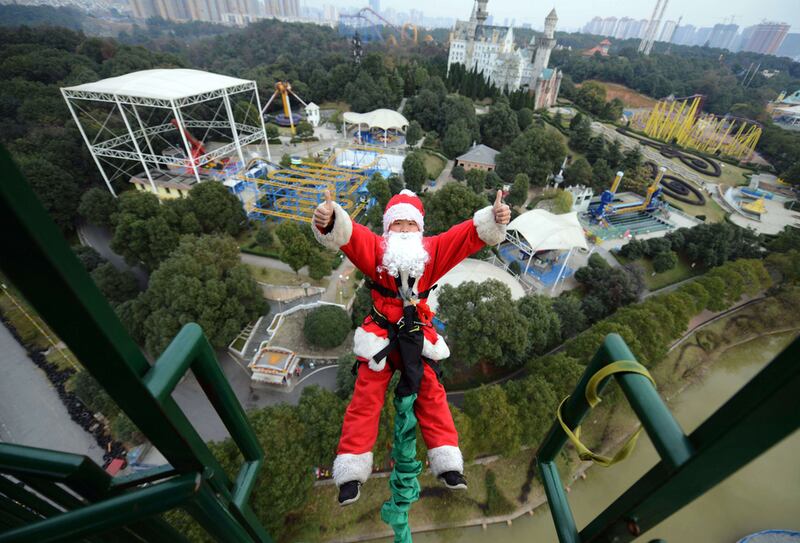BEIJING // Christmas was once banned in China. But in recent years this Christian festival has exploded in the aethist nation, with retailers using everything from saxophones and Smurfs to steam trains and carousels to encourage shoppers to open their wallets.
Anyone walking into a shopping mall is bombarded with festive sights and sounds: shop windows are bedecked with plastic Christmas trees, garlands and baubles, while the strains of Jingle Bells fill the air.
On the streets, banners reading “Happy Christmas” hang from schools and hotels, while festive messages are splashed across adverts and the media. In many restaurants, staff wear Santa Claus hats topped with felt reindeer antlers.
Christmas is celebrated widely across Asia, particularly in commercial centres like Japan and Hong Kong, where it has become a major shopping holiday devoid of most religious trappings.
It has particularly gathered momentum in China since 2010, when then vice president Xi Jinping, now the country’s head of state, popped into Father Christmas’s cabin during a visit to Finland.
“At shopping malls, Santa has become a promotional tool for pushing Christmas sales — and Chinese like to shop,” said Sara Jane Ho, founder of a finishing school popular among Beijing’s wealthy.
This year she has noted a growth in the number of young Father Christmases, his traditional beard and rounded belly replaced by a saxophone.
“[The] saxophone is seen as a very Western thing, and Santa Claus is seen as a very Western thing, so it’s almost natural they go together,” said Ms Ho.
In China almost anything seen as Western is used to evoke Christmas: teddy bears, the Seven Dwarves, fairground carousels or even steam trains.
Last year, a shopping mall in Shanxi province featured a giant Father Christmas, the edge of his jacket lifted as if caught by a gust of breeze in emulation of Marilyn Monroe.
This Christmas craze is mainly limited to young urbanites from the middle or upper classes, however.
“At my home in the country, people don’t celebrate Christmas,” said Guo Dengxiu, a migrant from eastern Anhui province. “By contrast, their children who have moved to the city celebrate it: on December 24, they meet with friends and go out to have fun.”
Many so-called Christmas “traditions” are brought back by young Chinese who have studied abroad, said Ms Ho. But the holiday often bears more resemblance to Valentine’s Day than the commemoration of the birth of Jesus Christ.
“In the West, you have a big [home-cooked] meal with your family ... you exchange gifts, and afterwards you would attend a Church service,” she said.
“In China, you have a big meal at a restaurant, with friends or with your romantic significant other — so it’s a romantic date — and it would be followed by going to the cinema, karaoke, clubbing or a costume party.”
But traditional Chinese holidays, such as Lunar new year celebrations, remain important occasions for families to get together, said professor Benoit Vermander from Fudan University in Shanghai.
Professor Vermander sees China’s love of Christmas as “a close mixture between attraction to ‘globalised’ Western customs and a fascination with religion, which is clearly shown by the popularity of Christianity in the big cities of the East”.
“China celebrates both Christmas and the Western new year and, a few weeks later, the Chinese new year. In this way, it has two cultural identities: one reflecting its ancestral culture and the other reflecting globalised culture, borrowing from Christian tradition,” he said.
The popularity rise of Christmas has also been driven by swelling numbers of Christians in the world’s most populous country.
The last official figures, from 2010, say there are 23 million Protestants and 5.7 million Catholics in China, but some estimate they could number several times more than that.
China’s communist authorities exercise strict control over religion and only allow Christians to join government-sanctioned churches.
This has prompted the spread of underground congregations — particularly Protestant ones — whose followers often complain of religious persecution.
But some in China see the rise of Christmas as stemming more from the weakening of traditional values.
The “Christmas frenzy” represents a “shipwreck” of the Chinese culture, according to a paper written by a group of 10 Chinese doctorate students, published by the Taiwan-based Institut Ricci this month.
“After more than 100 years during which the Chinese have subverted the course of their own history, violently condemned their own culture and denounced their own traditions, Chinese culture, especially Confucianism, has officially disappeared and completely sunk,”
they wrote.
* Agence France-Presse





